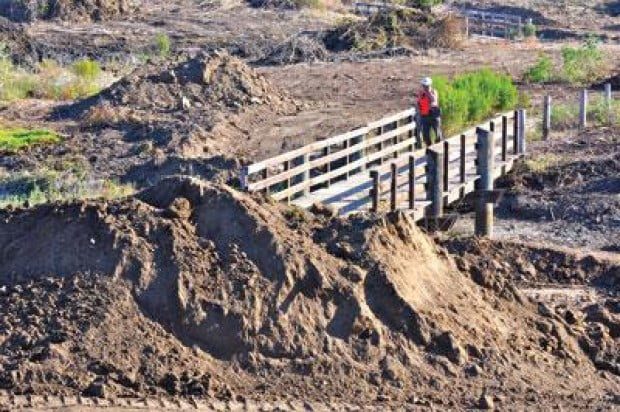
California State Parks still awaiting approval from Coastal for de-watering.
By Knowles Adkisson / Associate Editor
Earthmoving machinery moved into the Malibu Lagoon Wednesday last week and began tearing out trees and building an earthen dike to separate the lagoon’s western channels from Malibu Creek. The dike was expected to be completed by the end of the day Tuesday or on Wednesday this week, according to officials from California State Parks officials, the sponsor of the project.
Opponents to the project expressed surprise that the machines, called excavators, began so soon. State Parks officials had originally indicated that use of the excavators was weeks away. But State Parks officials now say those plans changed when the lagoon berm breached over the night on Saturday, June 9.
As of Friday, June 8, water levels in the lagoon were high because the berm separating the lagoon from the ocean was closed. Under its project plan, State Parks had one alternative for how to proceed if the berm was closed and if it was open, said Craig Sap, Angeles district superintendent for State Parks.
“We were going on a closed berm scenario,” Sap said.
The agency was also at the time still awaiting clarification from the California Coastal Commission on what construction it could and could not do, said Sap. As of June 8, Sap said State Parks officials thought they needed approval from the California Coastal Commission on a dewatering permit to begin construction in the lagoon.
But over the night on Saturday, June 9, the berm breached, emptying most of the water in the lagoon, much of it highly infected, into the ocean. The following Monday, Sap said State Parks received clarification from the Coastal Commission that the removal of vegetation and the construction of fences to cordon fish and wildlife into the lagoon was permitted. The suddenly reduced water level also offered a chance to trap and remove tidewater gobies, an endangered species of fish present in the lagoon. Dewatering of the lagoon cannot begin until all the tidewater gobies in the lagoon are gone.
“The breach on Sunday morning gave us the opportunity to get in there immediately. We were scrambling to get people on Monday,” Sap said. “We were calling in seasonal lifeguards, anybody, to help us put those sandbags in place to start that process.”
On Tuesday morning, Sap called Malibu City Manager Jim Thorsen and notified him that work would be beginning, although Thorsen says Sap “wasn’t sure what the order of work [would be].”
Malibu Mayor Laura Rosenthal returned Wednesday morning last week from speaking against the project at the Coastal Commission’s meeting in Huntington Beach to find the excavators at work.
“It was a surprise. We were all surprised,” Rosenthal said. “I looked at it from the vantage point of the Adamson house, and it’s right there.”
Protesters who opposed the project were distraught at the work being done after more than a year of attempts to delay the project so it could be redesigned or stop it entirely.
Project opponent Alden Marin, in a letter to the editor, blamed City of Malibu officials for not coming out in opposition to the project before it was too late.
“To say I’m extremely disappointed in this now (apparently) after the fact Lagoon situation—is an understatement,” Marin wrote. “Simply stated—[the Malibu City Council] did NOT fight hard enough for our treasure and you let us down.”
Approximately 100 opponents of the restoration project, which will use excavators to dredge and reshape the lagoon with the goal of improving water flow and water quality, showed up to the Malibu City Council’s regular meeting Monday night last week. Many expressed outrage that the berm had been breached, which admittedly aided State Parks’ plan to go ahead with the project.
“It would have been more difficult for the bulldozers to get in there obviously, with the water level as it was,” Sap said.
But Sap denied that anyone at State Parks was involved in artificially breaching the lagoon as a way of helping the project forward.
“No. No. It was a complete surprise,” Sap said. “…What you should know, it’s against state law. I mean, no one at State Parks, knowingly, even by proxy, would have somebody do that. Careers can be ruined by such things. The amount of scrutiny on this thing, there’s people watching it. You can see all these [protesters] taking shifts, watching it at night. So if somebody did do it, it’s surprising that no one saw them.”
Sap said State Parks rangers did an investigation into the breach on Monday, looking for footprints or tire tracks in the sand around the breach, but were unable to find anything.
Lagoon project protester Marcia Hanscom speculated at the Monday night City Council meeting that the Tapia treatment plant upstream from the lagoon had discharged and punctured the berm.
Thorsen said the City of Malibu called the treatment plant and was told no discharges had been done in the last 60 days.
Although the water level in the lagoon has been drastically reduced after the breach, dewatering is still yet to be done. Goode said the Coastal Commission still had to approve the final dewatering plan presented to it by State Parks. Goode expected dewatering to start next week. She said a copy of the dewatering plan would be shown to the City of Malibu, which has criticized the dewatering plan in the past, before work begins.
Several large sycamore trees that were planted in 1983 were dug up and will be sunk at the bottom of the lagoon near the Adamson house for fish habitat, and others will be cut up into benches to be placed at the proposed wildlife viewing area.
“They had to be removed because that’s going to be part of the new lagoon, so they couldn’t stay there,” Goode said.

